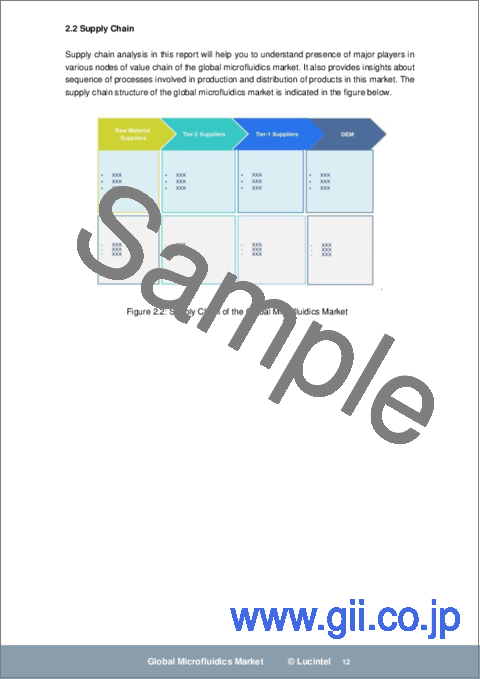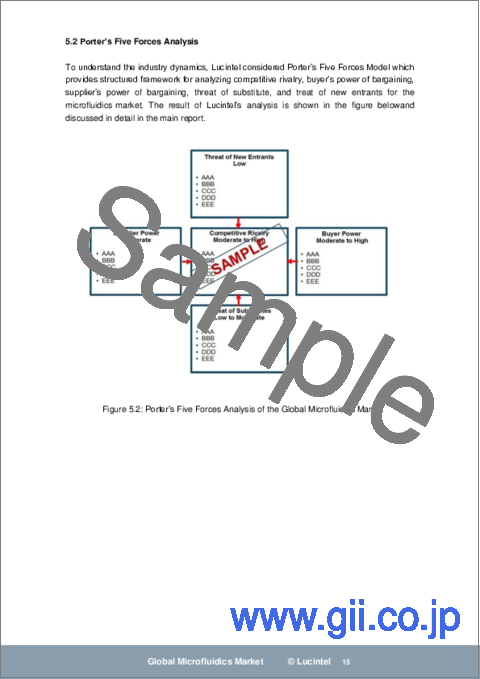|
|
市場調査レポート
商品コード
1356905
マイクロ流体市場レポート:2030年までの動向、予測、競合分析Microfluidics Market Report: Trends, Forecast and Competitive Analysis to 2030 |
||||||
|
● お客様のご希望に応じて、既存データの加工や未掲載情報(例:国別セグメント)の追加などの対応が可能です。 詳細はお問い合わせください。 |
|||||||
| マイクロ流体市場レポート:2030年までの動向、予測、競合分析 |
|
出版日: 2023年09月01日
発行: Lucintel
ページ情報: 英文 150 Pages
納期: 3営業日
|
- 全表示
- 概要
- 目次
マイクロフルイディクスの動向と予測
世界のマイクロ流体市場は、2024年から2030年までのCAGRが13.8%で、2030年までに推定655億米ドルに達すると予想されています。この市場の主な促進要因は、分析および臨床研究活動の増加、がん、糖尿病、心血管疾患などの慢性疾患の有病率の上昇、ポイントオブケア診断の需要の高まりです。世界のマイクロ流体市場の将来は、ラボオンチップ、臓器オンチップ、連続流マイクロ流体、光流体・マイクロ流体、音響流体・マイクロ流体、電気泳動・マイクロ流体市場にビジネスチャンスがあり、有望視されています。
マイクロ流体市場の洞察
- Lucintelの予測では、医療/ヘルスケアはバイオ分析、化学合成、情報技術の分野で重要な役割を果たしているため、予測期間中に高い成長が見込まれます。
- この市場の中で、ラボオンチップは7分でウイルスや細菌を超高速検出できる大きな可能性を持っているため、最大セグメントであり続けると思われます。
- 北米は、ヘルスケア支出の増加と政府機関による研究資金の増加により、予測期間中最大の地域であり続けると思われます。
本レポートでは、以下の11の主要な質問に回答している:
- Q.1.市場セグメントのうち、最も有望かつ高成長な機会は何か?
- Q.2.どのセグメントがより速いペースで成長するのか、またその理由は?
- Q.3.今後成長が加速すると思われる地域とその理由は?
- Q.4.市場力学に影響を与える主な要因は何か?市場における主な課題とビジネスリスクは?
- Q.5.この市場におけるビジネスリスクと競合の脅威は?
- Q.6.この市場における新たな動向とその理由は?
- Q.7.市場における顧客の需要の変化にはどのようなものがありますか?
- Q.8.この市場における新たな開発と、その開発をリードしている企業は?
- Q.9.この市場における主要企業は?主要企業は事業成長のためにどのような戦略的取り組みを進めているのか?
- Q.10.この市場における競合製品にはどのようなものがあり、材料や製品の代替による市場シェア低下の脅威はどの程度ありますか?
- Q.11.過去5年間にどのようなM&Aが行われ、業界にどのような影響を与えましたか?
目次
第1章 エグゼクティブサマリー
第2章 世界のマイクロ流体市場:市場力学
- イントロダクション、背景、分類
- サプライチェーン
- 業界の促進要因と課題
第3章 2018年から2030年までの市場動向と予測分析
- マクロ経済動向(2018~2023年)と予測(2024~2030年)
- 世界のマイクロ流体市場の動向(2018-2023)と予測(2024-2030)
- 技術別の世界のマイクロ流体市場
- 医療・ヘルスケア
- 非医療用
- 材料別の世界のマイクロ流体市場
- ケイ素
- ガラス
- ポリマー
- PDMS
- その他
- アプリケーション別の世界のマイクロ流体市場
- ラボオンチップ
- 臓器オンチップ
- 連続フローマイクロ流体工学
- 光流体工学とマイクロ流体工学
- 音響流体学とマイクロ流体学
- 電気泳動とマイクロ流体工学
- その他
第4章 2018年から2030年までの地域別の市場動向と予測分析
- 地域別の世界のマイクロ流体市場
- 北米のマイクロ流体市場
- 欧州のマイクロ流体市場
- アジア太平洋マイクロ流体市場
- その他地域マイクロ流体市場
第5章 競合の分析
- 製品ポートフォリオ分析
- 運用上の統合
- ポーターのファイブフォース分析
第6章 成長機会と戦略分析
- 成長機会分析
- テクノロジー別の世界のマイクロ流体市場の成長機会
- 材料別の世界のマイクロ流体市場の成長機会
- アプリケーション別の世界のマイクロ流体市場の成長機会
- 地域別の世界のマイクロ流体市場の成長機会
- 世界のマイクロ流体市場の新たな動向
- 戦略的分析
- 新製品の開発
- 世界のマイクロ流体市場の能力拡大
- 世界のマイクロ流体市場における合併、買収、合弁事業
- 認証とライセンシング
第7章 有力企業の企業プロファイル
- Illumina
- F. Hoffmann-La Roche
- PerkinElmer
- Agilent Technologies
- Bio-Rad Laboratories
- Danaher Corporation
- Abbott
- Thermo Fisher Scientific
- Standard BioTools
Microfluidics Trends and Forecast
The future of the global microfluidics markets looks promising with opportunities in the lab-on-a-chip, organs-on-chips, continuous flow microfluidics, optofluidics and microfluidics, acoustofluidics and microfluidics, and electrophoresis and microfluidics markets. The global microfluidics markets is expected to reach an estimated $65.5 billion by 2030 with a CAGR of 13.8% from 2024 to 2030. The major drivers for this market are an increase in analytical and clinical research activities, rising prevalence of chronic diseases, such as cancer, diabetes and cardiovascular disease, and growing demand of point-of-care diagnostics.
A more than 150-page report is developed to help in your business decisions.
Microfluidics by Segment
The study includes a forecast for the global microfluidics by technology, material, application, and region.
Microfluidics Markets by Technology [Shipment Analysis by Value from 2018 to 2030]:
- Medical/Healthcare
- Non-medical
Microfluidics Markets by Material [Shipment Analysis by Value from 2018 to 2030]:
- Silicon
- Glass
- Polymer
- PDMS
- Others
Microfluidics Markets by Application [Shipment Analysis by Value from 2018 to 2030]:
- Lab-on-a-chip
- Organs-on-chips
- Continuous Flow Microfluidics
- Optofluidics and Microfluidics
- Acoustofluidics and Microfluidics
- Electrophoresis and Microfluidics
- Others
Microfluidics Markets by Region [Shipment Analysis by Value from 2018 to 2030]:
- North America
- Europe
- Asia Pacific
- The Rest of the World
List of Microfluidics Companies
Companies in the market compete on the basis of product quality offered. Major players in this market focus on expanding their manufacturing facilities, R&D investments, infrastructural development, and leverage integration opportunities across the value chain. With these strategies microfluidics companies cater increasing demand, ensure competitive effectiveness, develop innovative products & technologies, reduce production costs, and expand their customer base. Some of the microfluidics companies profiled in this report include-
- illumina
- F. Hoffmann-La Roche
- Perkinelmer
- Agilent Technologies
- Bio-Rad Laboratories
- Danaher Corporation
- Abbott
- Thermo Fisher Scientific
- Standard Biotools
Microfluidics Market Insights
- Lucintel forecasts that medical/healthcare is expected to witness higher growth over the forecast period due to they play an important role in the fields of bioanalytical, chemical synthesis and information technology.
- Within this market, lab-on-a-chip will remain the largest segment as it possess the great potential for ultra-fast virus and bacteria detection in seven minutes.
- North America will remain the largest region over the forecast period due to increasing healthcare expenditure and growing funding for research by government agencies in the region.
Features of the Global Microfluidics Markets
- Market Size Estimates: Microfluidics markets size estimation in terms of value ($B).
- Trend and Forecast Analysis: Market trends (2018 to 2023) and forecast (2024 to 2030) by various segments and regions.
- Segmentation Analysis: Microfluidics markets size by technology, material, application, and region. in terms of value ($B).
- Regional Analysis: Microfluidics markets breakdown by North America, Europe, Asia Pacific, and Rest of the World.
- Growth Opportunities: Analysis of growth opportunities in different technologies, materials, applications, and region.s for the microfluidics markets.
- Strategic Analysis: This includes M&A, new product development, and competitive landscape of the microfluidics markets.
- Analysis of competitive intensity of the industry based on Porter's Five Forces model.
FAQ
Q.1. What is the microfluidics markets size?
Answer: The global microfluidics markets is expected to reach an estimated $65.5 billion by 2030.
Q.2. What is the growth forecast for microfluidics markets?
Answer: The global microfluidics markets is expected to grow with a CAGR of 13.8% from 2024 to 2030.
Q.3. What are the major drivers influencing the growth of the microfluidics markets?
Answer: The major drivers for this market are an increase in analytical and clinical research activities, rising prevalence of chronic diseases, such as cancer, diabetes and cardiovascular disease, and growing demand of point-of-care diagnostics.
Q.4. What are the major segments for microfluidics markets?
Answer: The future of the microfluidics markets looks promising with opportunities in the lab-on-a-chip, organs-on-chips, continuous flow microfluidics, optofluidics and microfluidics, acoustofluidics and microfluidics, and electrophoresis and microfluidics markets.
Q.5. Who are the key microfluidics markets companies?
Answer: Some of the key microfluidics companies are as follows:
- illumina
- F. Hoffmann-La Roche
- PerkinElmer
- Agilent Technologies
- Bio-Rad Laboratories
- Danaher Corporation
- Abbott
- Thermo Fisher Scientific
- Standard BioTools
Q.6. Which microfluidics markets segment will be the largest in future?
Answer: Lucintel forecasts that medical/healthcare is expected to witness higher growth over the forecast period due to they play an important role in the fields of bioanalytical, chemical synthesis and information technology.
Q.7. In microfluidics markets, which region is expected to be the largest in next 5 years?
Answer: North America will remain the largest region over the forecast period due to increasing healthcare expenditure and growing funding for research by government agencies in the region.
Q.8. Do we receive customization in this report?
Answer: Yes, Lucintel provides 10% customization without any additional cost.
This report answers following 11 key questions:
- Q.1. What are some of the most promising, high-growth opportunities for the microfluidics markets by technology (medical/healthcare and non-medical), material (silicon, glass, polymer, PDMs, and others), application (lab-on-a-chip, organs-on-chips, continuous flow microfluidics, optofluidics and microfluidics, acoustofluidics and microfluidics, and electrophoresis and microfluidics), and region. (North America, Europe, Asia Pacific, and the Rest of the World)?
- Q.2. Which segments will grow at a faster pace and why?
- Q.3. Which region will grow at a faster pace and why?
- Q.4. What are the key factors affecting market dynamics? What are the key challenges and business risks in this market?
- Q.5. What are the business risks and competitive threats in this market?
- Q.6. What are the emerging trends in this market and the reasons behind them?
- Q.7. What are some of the changing demands of customers in the market?
- Q.8. What are the new developments in the market? Which companies are leading these developments?
- Q.9. Who are the major players in this market? What strategic initiatives are key players pursuing for business growth?
- Q.10. What are some of the competing products in this market and how big of a threat do they pose for loss of market share by material or product substitution?
- Q.11. What M&A activity has occurred in the last 5 years and what has its impact been on the industry?
Table of Contents
1. Executive Summary
2. Global Microfluidics Markets : Market Dynamics
- 2.1: Introduction, Background, and Classifications
- 2.2: Supply Chain
- 2.3: Industry Drivers and Challenges
3. Market Trends and Forecast Analysis from 2018 to 2030
- 3.1. Macroeconomic Trends (2018-2023) and Forecast (2024-2030)
- 3.2. Global Microfluidics Markets Trends (2018-2023) and Forecast (2024-2030)
- 3.3: Global Microfluidics Markets by Technology
- 3.3.1: Medical/Healthcare
- 3.3.2: Non-medical
- 3.4: Global Microfluidics Markets by Material
- 3.4.1: Silicon
- 3.4.2: Glass
- 3.4.3: Polymer
- 3.4.4: PDMS
- 3.4.5: Others
- 3.5: Global Microfluidics Markets by Application
- 3.5.1: Lab-on-a-chip
- 3.5.2: Organs-on-chips
- 3.5.3: Continuous Flow Microfluidics
- 3.5.4: Optofluidics and Microfluidics
- 3.5.5: Acoustofluidics and Microfluidics
- 3.5.6: Electrophoresis and Microfluidics
- 3.5.7: Others
4. Market Trends and Forecast Analysis by Region from 2018 to 2030
- 4.1: Global Microfluidics Markets by Region
- 4.2: North American Microfluidics Markets
- 4.2.3: North American Microfluidics Markets by Application: Lab-on-a-chip, Organs-on-chips, Continuous Flow Microfluidics, Optofluidics and Microfluidics, Acoustofluidics and Microfluidics, Electrophoresis and Microfluidics, and Others
- 4.3: European Microfluidics Markets
- 4.3.1: European Microfluidics Markets by Technology: Medical/Healthcare and Non-medical
- 4.3.2: European Microfluidics Markets by Application: Lab-on-a-chip, Organs-on-chips, Continuous Flow Microfluidics, Optofluidics and Microfluidics, Acoustofluidics and Microfluidics, Electrophoresis and Microfluidics, and Others
- 4.4: APAC Microfluidics Markets
- 4.4.1: APAC Microfluidics Markets by Technology: Medical/Healthcare and Non-medical
- 4.4.2: APAC Microfluidics Markets by Application: Lab-on-a-chip, Organs-on-chips, Continuous Flow Microfluidics, Optofluidics and Microfluidics, Acoustofluidics and Microfluidics, Electrophoresis and Microfluidics, and Others
- 4.5: ROW Microfluidics Markets
- 4.5.1: ROW Microfluidics Markets by Technology: Medical/Healthcare and Non-medical
- 4.5.2: ROW Microfluidics Markets by Application: Lab-on-a-chip, Organs-on-chips, Continuous Flow Microfluidics, Optofluidics and Microfluidics, Acoustofluidics and Microfluidics, Electrophoresis and Microfluidics, and Others
5. Competitor Analysis
- 5.1: Product Portfolio Analysis
- 5.2: Operational Integration
- 5.3: Porter's Five Forces Analysis
6. Growth Opportunities and Strategic Analysis
- 6.1: Growth Opportunity Analysis
- 6.1.1: Growth Opportunities for the Global Microfluidics Markets by Technology
- 6.1.2: Growth Opportunities for the Global Microfluidics Markets by Material
- 6.1.3: Growth Opportunities for the Global Microfluidics Markets by Application
- 6.1.4: Growth Opportunities for the Global Microfluidics Markets by Region
- 6.2: Emerging Trends in the Global Microfluidics Markets
- 6.3: Strategic Analysis
- 6.3.1: New Product Development
- 6.3.2: Capacity Expansion of the Global Microfluidics Markets
- 6.3.3: Mergers, Acquisitions, and Joint Ventures in the Global Microfluidics Markets
- 6.3.4: Certification and Licensing
7. Company Profiles of Leading Players
- 7.1:Illumina
- 7.2: F. Hoffmann-La Roche
- 7.3: PerkinElmer
- 7.4: Agilent Technologies
- 7.5: Bio-Rad Laboratories
- 7.6: Danaher Corporation
- 7.7: Abbott
- 7.8: Thermo Fisher Scientific
- 7.9: Standard BioTools




